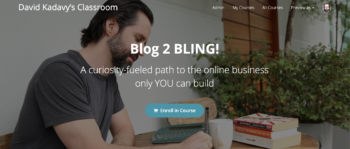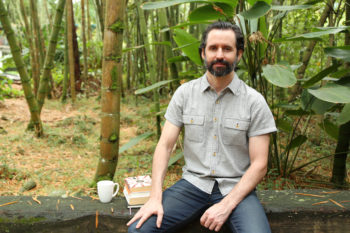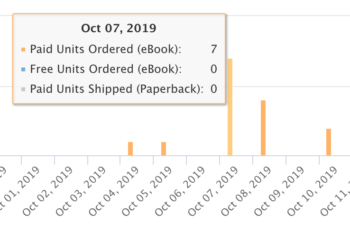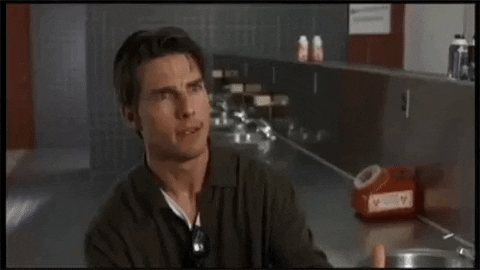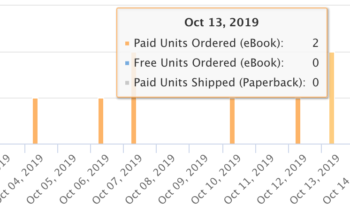Subscribe to blog updates via email »
September 2019 Income Report
An audio version of this income report is available to Patreon backers of certain levels »
September’s revenues were $9,661.16, down from August’s $10,406.47. Profits were $3,487.87, up slightly from August’s $3,442.10.

WANT TO WRITE A BOOK?
Download your FREE copy of How to Write a Book »
(for a limited time)
Still spending a lot on Amazon ads – for a thin profit
I continued to spend a lot on Amazon ads, and I continued to earn back a small amount more than I spent on those ads.
Overall ad spend was $4,968.08, and self-published book income was $5,722.04. That’s $753.96 profit, for an ROI of 15.18%.
I’m still doing some tweaks with systems to see if I can increase that ROI, but nothing seems to work. Even cutting out ads that seem to be unprofitable in the ads dashboard, while keeping the ones that seem to be wildly profitable, doesn’t seem to help. It’s hard to say, though, as I’m still always experimenting with new placements, and learning about those probably drops the ROI down a bit.
I would of course like to make more profit on my ads, but I’m glad to be above break-even, especially at such a large scale. Within that income is 874 sales of The Heart to Start. That’s a lot of books! And each of those readers can bring more readers. It takes time for the effects of influence like that to bear fruit.
The tremendous exposure of this high ad spend seems to be doing something to increase my reach. I continue to get more invites to be on podcasts or to appear in online summits. I’ll be updating my interviews page with my other appearances, as they go live.
Blog 2 BLING! opening soon
My main front-burner project right now – aside from writing 250 words a day on my next book – is re-opening Blog 2 BLING! With each iteration, the course is improving, and the marketing processes are getting refined.
The entire course is now loaded on Teachable (thanks to the help of a contractor on Fiverr). That’s going to be a massive improvement in experience over what I had before, which was just text files with links to YouTube playlists.
I now have the landing page mostly ready as well. There really seems to be a power to this course. It’s grounded in more than a decade of experience, and I’m realizing what this course really means. I feel it really does offer a unique point-of-view in a curiosity-driven way of building an online business.
A PhD in curiosity
I’ve been warming up the email list with the theme of a “Personal PhD,” or getting a “PhD in your curiosity.” This is the way I have approached my business from day one. Not a “PhD” in the sense that I’m trying to make new discoveries for humanity that are peer reviewed. Rather, a PhD in the sense that I try to take the pursuit of my curiosity to the ultimate level. Not to write in order to make money, but to make money in order to write.
With the new upgrades to the experience and my recognition of the value of this course, I’m upping the price again. In fact, I’m doubling the price. In the last launch in February/March B2B was $249. This time around, it’s $499. I suspect that will attract students of a higher level of motivation, and may serve to motivate them more, as well.
Webinar coming up
I’ll be re-opening the B2B cart at the end of my upcoming webinar, Self-Motivation for Solopreneurs. I’ve given this webinar before, and I fortunately have a script for it that I can make some tweaks to to see if I can improve it in each iteration.
I’m trying many new things in this iteration with how I run the webinar. Previously, I scheduled a live encore webinar to follow my initial live webinar. The initial live webinar was during the day, and the encore was held at night – both during the week. The offer was then sent only to people who attended one of the webinars, and that cohort had its own cart-closing date.
After the live webinars, the replay then opened up. Those who attended the replay had their own enrollment window. Only then did I send the offer to the entire list, which, yet again, had its own enrollment window.
The result was that the cart was opened and then closed every week for three weeks. It got complicated.
Simplifying the sequence
This time, I’m only doing one live webinar. For the first time ever, I’m holding the webinar on a Sunday night, and I’m planning on closing the cart the following Sunday night. My thinking is that maybe the weekend is a time when people have more bandwidth to think about side projects such as growing an online business. The downside is of course that I have to do some work two Sundays in a row, when I have my own catching up to do!
The cart will be open the whole week, and I’ll market pretty much the same to people who attended the webinar, and those who didn’t. I’ll use ActiveCampaign’s Message Variables to change any messaging within my much-simplified automation.
As I’m typing this, I’m wondering if I should keep the cart open for longer than a week. A $499 price point may call for more time to think about it. I’m not sure. On the other hand, $499 is nothing to many people, especially when it involves something as important as finding a way to make it on their own.
None of the changes I’m making are isolated, so I of course am not “A/B testing” in a manner that would allow me to attribute an increase or decrease performance to any one thing in particular.
Blog 2 BLING! revenue prediction (& how to score predictions in general)
Since I’m trying to get into the habit of making predictions, let’s do it. I still struggle with how to “score” the success of predictions. If I were to, say, try to pick a range within which I have 80% confidence that the sales performance will fall, I could be incredibly wide with my window, and then I could proclaim myself a master predictor.
Maybe the range I choose needs to be restricted by some percentage of itself? I’m tempted to 80/20 the effort of predicting by trying to choose a range that I’m 80% sure I’ll fall within, but that range can only be a 20% difference between high end and low end.
For example, if I were to predict $5,000 high-end revenue from this launch, a 20% range from that high-end would bring me to a $4,000–$5,000 range. But would I have an 80% confidence rate that I would fall within that range?
Balancing range of prediction with confidence level
It seems that my level of confidence and the range of my prediction should have nothing to do with each other. But the fact remains that it’s a good idea to have some way of restricting the range of my prediction.
What if it were a 70/30 relationship? I would have to find a 30% range within which I would have 70% confidence my revenue would fall. So in the above hypothetical case, that range would be $3,500–$5,000. That does feel like more of a range where I would be comfortable saying I was 70% of falling within.
Okay, so now that we have that hypothetical out of the way, what is the 30% range within which I have 70% confidence my revenue will fall?
Starting with the base rate
First, let’s look at the performance of the prior webinar. In March, I booked $3,547 on 16 sales (with a basic & premium package). That’s about $216 per sale.
How many people did I market the course to? I’m surprised to look back and see that I emailed about 23,000 people about the webinar. This was apparently before I divided my email list into D4H and non-D4H lists (such as Love Mondays).
I don’t even have 23,000 active email subscribers anymore. I got rid of some inactive subscribers. Actually, the list that I plan to market to – which I call GAD (for “Getting Art Done”) – is about 7,800 people. Much smaller.
Thinking independently of price, 16 customers from 23,000 subscribers would be about a 0.06% conversion rate. If I had that same conversion rate this time around, that would translate into about 4.6 sales.
Determining influential factors
However, a number of factors are different:
- I have slightly more focused subscribers on my list. D4H subscribers are interested in design. GAD subscribers are somewhat more interested in building online businesses. It’s not a direct hit, but probably slightly more targeted.
- I’ve pruned that list such that the contacts I do have are more engaged. My emails consistently get more than a 30% open rate. My emails in the last launch got around a 20% open rate.
- The product experience is much better. People who buy online courses have most likely bought other courses hosted on Teachable, so they’re familiar with the experience.
- I actually have a landing page now. As I’ve said before landing pages are for wimps in the early stages of a product.
- The price is DOUBLE what it once was.
- I don’t currently have plans to offer a lower-priced “basic” package, nor do I currently have plans for any upsells. I had both of these on the previous launch, and both of those can really increase revenue.
- This time around, I will be offering a high-dollar “coaching” package. It’s priced at a little under $9,000. I honestly don’t expect any sales of that package, but just one sale would make a huge difference in my overall launch revenue. I predict with 90% certainty that I won’t have sales of that package.
- I’m doing not two, but only one live webinar.
- I’m doing my live webinar on a Sunday night, instead of mid-day, mid-week.
Scoring factors to adjust performance prediction
I can now go through those factors one by one, Phillip Tetlock style, to adjust my prediction. I’m starting with a “performance factor,” the expected change in conversation rate, of 1. 1 x 0.06% = 0.06%.
- For more-focused subscribers, I expect a 30% increase in performance. Performance factor = 1.3.
- For more engaged subscribers, I expect a 50% increase in performance (same as increase in open rate). Performance factor = 1.95.
- For a better product experience, I expect a 50% increase in performance. Performance factor = 2.925.
- For the landing page, I expect another 50% increase in performance. Performance factor = 4.39.
- For doubling the price, I expect a 30% drop in conversion of sales. Performance factor = 3.07.
- For not having tiered pricing nor upsells, I expect a 30% drop in dollars per sale. Performance factor = 2.15.
- I don’t expect to make sales with the coaching package, and making a sale is binary, so I don’t expect an increase in sales from that. But I expect a 5% increase in sales from a price-anchoring effect. Performance factor = 2.25.
- For doing only one live webinar, I expect a 10% decrease in sales. Performance factor = 2.03.
- For doing the live webinar Sunday night, I expect a 5% increase in sales. Performance factor = 2.13.
So, I’m expecting a conversion rate of not 0.06%, but 0.128%. Out of 7,800 contacts, that’s 9.98 sales. Let’s make it 10.
Calculating final revenue
I expect half of those to go for the $99 x 6 payment plan, each for a total revenue of $594. Five of those equals $2,970. Add onto that another five at $499, and you’ve got a total estimated revenue of $5,465.
Let’s make $5,500 our mid-point of our 30% estimate. So we’re looking roughly at a high end of $6,500.
Making the prediction
So I’m 70% confident the sales from the next launch of Blog 2 BLING! will be within the range of $4,550–$6,500.
Caveats
In some ways, that range feels overly-optimistic. It’s nearly double the revenue of my previous launch.
Then again, I really do feel there’s something fundamentally different about the course experience and sales process now, plus the price point is higher, so it’s totally possible.
Of course, all of the estimates I’ve made on how the various factors will influence sales are complete guesses, and the list of factors is incomplete.
Also, all it takes is one coaching package sale to blow that estimate out of the water.
I can also see how the act of making that estimate could motivate me to work harder, resulting in even better – and thus inaccurate on the high side – performance. According to my estimate, I’m missing out on a lot by not having a basic plan and upsells. 30% more would be more $1,650 more revenue! Could be worth the effort.
Additionally, I’m making this up as I go. If anyone knows better ways to make and measure predictions, let me know! And I’ll have to keep studying up on it.
New photos!
Part of the reason I feel good about the sales prospects of this iteration of Blog 2 BLING! Is that I have some new photos on the landing page.
I had some extra AirBNB credits that were expiring soon, and they weren’t substantial enough to do much in terms of lodging. So, I booked a photo shoot in Medellín, through AirBNB Experiences.
I think these photos really help tell the story of the mission I’ve been on the past few years, moving to South America to double down on writing. It confirms the real images that have already been painted in the minds of my readers and listeners.
New short read: Ten Passive Income Ideas
I’ve already used one of my new photos in marketing a new short read that I released in September. Ten Passive Income Ideas is about 3,500 words, and quickly tells the story of ten different ways that I’ve actually made passive income over the years.
Passive income is something that I haven’t written about a lot, but it’s been incredibly important to my business. You can see that’s so with some of the passive streams I have going in these reports, such as my affiliate earnings from ActiveCampaign.
I wasn’t planning on writing this book at all. One morning, as I was evaluating my priorities in the business, and I thought to myself that it would be nice to have some kind of lead magnet to find people who would be interested in Blog 2 BLING!
I started to brainstorm how I could have, as a lead magnet, a simple list of passive income ideas. That simple list soon turned into a series of stories of how I had actually earned passive income myself, and that brainstorm session turned into a full-blown writing session.
I wrote the entire first draft in one sitting, that morning. I later cleaned it up and laid it out in an ebook.
One way I came up with the idea in the first place was that I was looking for something to act as a lead magnet to turn Instagram followers into email subscribers. I put my call to action at the end of an informative carousel post.
https://www.instagram.com/p/B2zIBe7p_4e/
I made a lead magnet for Blog 2 BLING!, I got a chance to practice my Instagram marketing through another carousel post, and I got to use one of my new photos. It was a win-win-win!
Once my free offer was over, I needed another place to direct people who would see the Instagram post. So, I published Ten Ideas on Kindle. Without any marketing at all, one day early on, I sold seven copies!
Revenue from Ten Ideas will show up in the October income report.
Instagram influencer marketing bearing fruit
I introduced awhile back a new category for “advertising” in the form of “comped books.” I’ve dabbled with finding Instagrammers who share books who I think would like The Heart to Start.
Basically, I message them and offer to send a book. Then I send the information to my assistant, who orders an author copy through Amazon KDP.
I had my first big win from these efforts in September. @alexandbooks_ ran a giveaway to his 17k+ followers!
https://www.instagram.com/p/B2UQ7NMAp7H/
I can’t say for sure that it caused a big spike in sales, but I think it’s still hard to measure these things. As you can see, my comped-book expenses are very low!
I think there’s at least one more giveaway coming down the pike. I haven’t invested more time in these efforts, but it may be worth developing some recurring tasks that I can eventually delegate to an assistant.
Now laying out ebooks in Vellum
I surprised even myself in how quickly I published Ten Ideas. It’s thanks to my recent purchase of layout software, Vellum. It’s extremely easy to use.
In the process of preparing the Papyrus ebook, I broke down and finally purchased Vellum for $250. Vellum doesn’t allow the control that I had in creating ebooks with Sigil, but I simply didn’t have the patience to wade through a bunch of code again.
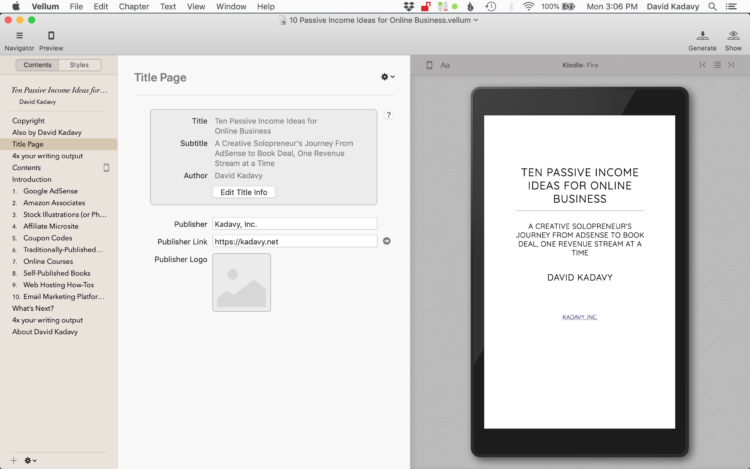
I invested $250 in a copy of Vellum, which makes it incredibly easy to produce beautiful print and ebooks.
The result with In Defense of Papyrus is a fine-looking ebook. The templates in Vellum look good, though the designer in me struggles not having more control over formatting.
I didn’t know if purchasing Vellum was a smart move for me, personally. I made the calculation as follows: It’s more work for me to make ebooks through Sigil than through Vellum. I also don’t have a lot of confidence that I can find a contractor who would make ebooks that would meet my design standards.
(I previously hired someone on Fiverr to create my ActiveCampaign Review ebook. The work was passable, but not for an ebook on typography.)
Easier publishing = more books published
If it’s difficult for me to produce ebooks, I will release fewer ebooks. Releasing short reads appears to be one of my points of difference. My self-publishing article in which I espouse the idea of publishing short reads continues to get attention. I get a mischievous sense of joy out of tearing down traditional ideas about what qualifies as a book.
So, though I didn’t plan to release more short reads, I figured that having Vellum available to me would prevent me from hesitating to publish more in the future.
Will I always use Vellum?
I doubt that I’ll use Vellum for my next full-length book. One of the points of difference I’m going for is publishing traditional-quality books as a self-published author. Vellum gets damn close to that. Probably most people wouldn’t know the difference between a traditionally-published book and one laid out in Vellum.
Sometimes being a designer is a curse. Maybe I’ll wrestle my way through Affinity Publisher, continue using my ancient version of Adobe InDesign – and risk being locked out of my layout in the future – or bite the bullet and pay for an InDesign subscription (which seems ridiculous, considering how little I use it).
Thinking of buying Vellum? Please use my affiliate link
Another good reason to buy Vellum is that they have an affiliate program. I can now say that I’ve used the product, and that I highly recommend it for most self-published authors, especially if you don’t have the budget to hire a designer and/or you don’t have the skills and/or desire to do it yourself. If Vellum interests you, please download through my affiliate link.
If you try the free trial and later decide to buy, please click through on my link again, before purchasing. It costs you nothing extra, and it’s a good way to thank me for the publishing knowledge I share.
200th episode of Love Your Work coming up
This week, I’m very proudly launching the 200th episode of Love Your Work. The episode is a reflection on my own internal journey in producing the podcast. What have I learned and how have I changed along the way?
I really feel that it’s one of my best episodes yet. I hope you will agree. I’m warning you, though – it’s a tear-jerker. Thanks for listening for four years!
Bi-yearly Design for Hackers earnings
I got one of my twice-yearly checks for Design for Hackers. The $725.13 I earned this September is far less than the $2,679.27 I earned in March, because that’s when I got paid an advance for a foreign-rights deal.
But, it’s still slightly more than the $660.80 I earned in September of last year. Eight years after its introduction, this short-shelf-life technology book is still paying dividends!
I sense that my recent self-publishing activity is breathing some new life into D4H. For example, I noticed one top-100 Amazon reviewer who reviewed HTS later reviewed D4H.
But, it’s hard to know how much impact that self-publishing activity is having. Especially because payments for sales happen at least six months after the sales are made. Prediction: I’m 70% confident that next September’s payment will be higher than this September’s payment.
HTS rejected for Kobo promotions
The Heart to Start has now been rejected twice for a promotion on Kobo. Recall that I went through the trouble of pulling HTS from Draft2Digital so I could publish directly through Kobo, so I could be eligible for such promotions.
I’m trying to help Kobo compete with Amazon, and so far, no luck. C’mon, Kobo…
But, I have started running some BookBub ads to drive Kobo sales. Performance hasn’t been great so far, but I haven’t spent enough for it to be worth going into.
HTS pricing promotion on Amazon UK
I ran a pricing promotion last week for HTS, only on the Amazon UK store. Instead of the usual price of £7.99, it was only £2.49. It hasn’t resulted in many sales.
The mystery of British readers
Running this UK promo reminded me that I still struggle to understand the psychology of British customers. Some of the reviews are kind of nasty. For example, this one.
Now, that’s fine that someone doesn’t like stories (another word for “path”), and finds ALL stories to be useless to them. I’m not surprised people like this exist.
What I am surprised by is that, despite the fact that there are twelve other Amazon.co.uk reviews from people whose opinions differ, this review has the most “helpful” votes, thus making it the most visible review.
I’m not surprised that a curmudgeon like this exists. What makes me scratch my head is that so many people agree with this person.
“[anyone’s] path…is [of] no use to me whatsoever” Who takes a comment like that seriously? Is all of humanity not run by stories? Do we not listen to music and watch plays and movies that are nothing but stories? Do we not gather together to sit in dark rooms with other apes, where we watch other apes pretend to be apes they are not? Is that not wired into our brains?
I don’t get how that could be a widely supported thought.
There are other reviews on other books on Amazon.co.uk that are even more puzzling. I won’t get into them.
I’m still struggling to understand UK readers. I don’t know whether it’s a good business decision to attempt to understand them, but I’m still curious.
I sense that the British are a lot more skeptical of anyone making a big deal of oneself, i.e. telling one’s own story. “Wankers,” I think they call them.
I also sense there’s a lot more ribbing going on in British culture. Calling one another “cunts” or “twats” as frequently as wishing someone the “top of the day.” Footage of British Parliament supports this theory. At the end of the day, I picture them all sharing a pint of Guinness.
Should negative reviews be addressed differently in the UK?
This brings up the question of how to interface with British reviewers. Some authors of course go by the policy of not interfacing with negative reviewers at all. But I’m curious about human nature, and interested in what you can sometimes learn when you do interface with someone who doesn’t like your work.
I think the American understanding of how to interface with an unhappy customer is to take a vaguely passive-aggressive yet exceedingly “nice” stance. To “kill them with kindness.” Basically, you act so nice that the unhappy customer can’t help but realize what a sourpuss they are. Sometimes they then revise or delete their review.
I tried that strategy with the aforementioned review, and I certainly can’t say that it has helped.
And why when you encounter someone who reveals themselves to be a colossal moron – I’m not saying this is the case with the aforementioned reviewer, but with other reviewers – why should you not call them out on it?
I know, I know, it makes you, the author look petty and insecure. That’s the American opinion anyway. But do the British, who seem to love a good ribbing, think that way, too?
Like, let’s say you have a book that says “short read” all over it. It’s in the title, on the cover, on the title page, and in the book’s description. Then someone gives you a one-star review, their central complaint being that the book is “short.”
I wish this was hypothetical. People this dumb exist.
Why shouldn’t such a person be tarred and feathered and ridiculed?
I guess one would say that other readers are smart enough to see that said reviewer is a little dull, and to make their own decision. One might also say, leave it up to other readers to do the tarring and feathering. Again, it makes you, as the author, look bad if you do it yourself.
But I’m not so sure. In the UK at least, I’m not so sure. And maybe it depends upon your “brand” as an author.
If any UK readers have insight into the psychology of UK customers, I’d love to hear it!
And now, I’ve talked waaaay too much about this. Making myself “look bad.”
Income
Book Sales
| Design for Hackers (all formats) | $725.13 |
| The Heart to Start Kindle | $3,631.70 |
| The Heart to Start Paperback (Amazon) | $948.75 |
| The Heart to Start “Wide” (non-Amazon) | $85.52 |
| The Heart to Start Audiobook | $207.28 |
| How to Write a Book Kindle | $372.91 |
| How to Write a Book Paperback | $354.63 |
| How to Write a Book “Wide” (non-Amazon) | $0.00 |
| How to Write a Book Audible | $51.33 |
| How to Write a Book Spanish Kindle | $16.02 |
| How to Write a Book Spanish Paperback | $10.21 |
| In Defense of Papyrus Kindle | $28.95 |
| In Defense of Papyrus Wide | $2.00 |
| Make Money Writing on the STEEM Blockchain Kindle | $7.81 |
| Make Money Writing on the STEEM Blockchain Paperback | $3.84 |
| Make Money Writing on the STEEM Blockchain Audible | $1.10 |
| Total Book Sales | $6,447.17 |
Digital Products
| Blog 2 BLING! (Beta) | $141.00 |
| D4H Video | $47.00 |
| Logo Mastery | $49.00 |
| Summer of Design | $6.00 |
| Total Digital Products | $243.00 |
Affiliates / Advertising
| Active Campaign | $1,651.85 |
| Amazon | $53.50 |
| Brave Browser | $76.04 |
| ConvertKit | $70.80 |
| Hostgator | $300.00 |
| Match.com free trial | $56.86 |
| SendOwl | $3.00 |
| Total Affiliates | $2,212.05 |
Love Your Work Podcast
| Patreon | $230.74 |
| PayPal Donations | $10.00 |
| Sponsors | $500.00 |
| Total LYW Podcast | $740.74 |
Services
| Medium | $18.20 |
| Total Services | $18.20 |
| GROSS INCOME | $9,661.16 |
Expenses
General
| Accounting | $265.00 |
| Outside Contractors | $289.88 |
| Podcast Editing / Publishing | $240.00 |
| Misc. Software | $259.69 |
| Total General | $1,054.57 |
Advertising
| Amazon | $4,802.30 |
| BookBub | $10.13 |
| Comped books | $63.31 |
| $12.34 | |
| Prestozon | $80.00 |
| Total Advertising | $4,968.08 |
Hosting
| Genius Link | $10.00 |
| Libsyn | $20.00 |
| Namecheap | $82.09 |
| SendOwl | $24.00 |
| Bookfunnel | $14.55 |
| Total Hosting | $150.64 |
| TOTAL EXPENSES | $6,173.29 |
| NET PROFIT | $3,487.87 |


